The expanded description and resumé are below the images.
TIME CAPSULE
Eduardo Kac
SHORT DESCRIPTION
Time Capsule consists of seven sepia photographs, an x-ray, and a flat screen. The video screen shows the artist implanting a microchip into his leg live on TV and on the Web. The x-ray shows the chip in the artist’s body. The photographs show the lives of the artist’s ancestors in Poland before 1939.
DESCRIPCIÓN CORTA
Time Capsule (La cápsula del tiempo) consiste precisamente en siete fotografías en sepia, una radiografía, y una pantalla plana. La pantalla plana muestra un video donde se puede ver el instante en el cual el artista se implantó un microchip en el tobillo en directo en la televisión y en la Red. La radiografia enseña el microchip en el cuerpo del artista. Las fotografías en sepia enseñan la vida de los antepasados del artista en Polonia en el periódo anterior al 1939.
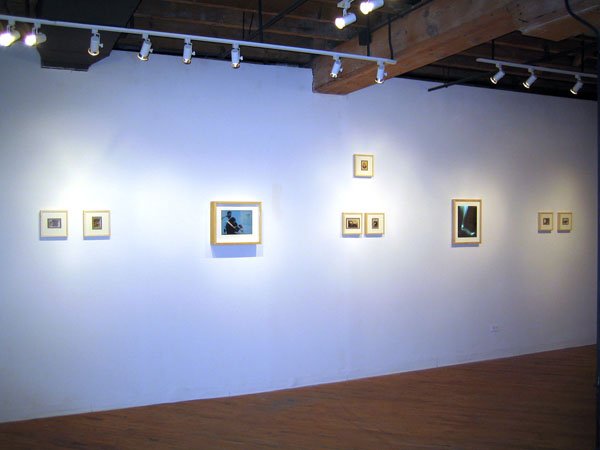
"Time Capsule" as seen at NIU Art Gallery, Chicago, 2005
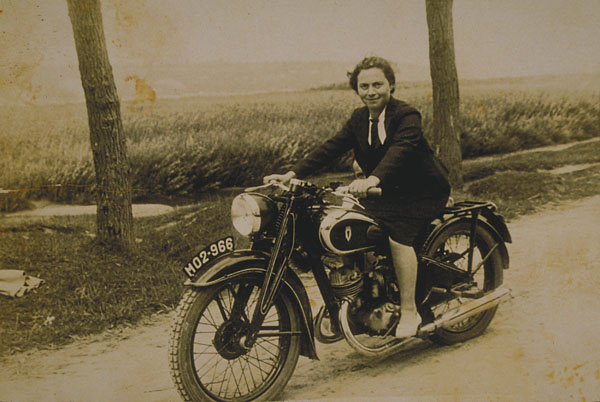
One of the seven sepia-toned photographs that make up "Time Capsule"
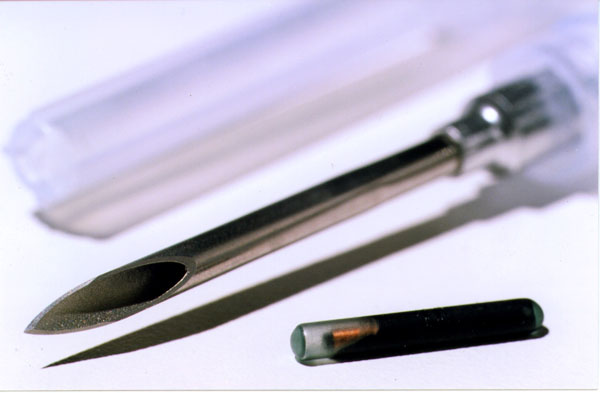
The syringe and the microchip used in "Time Capsule"
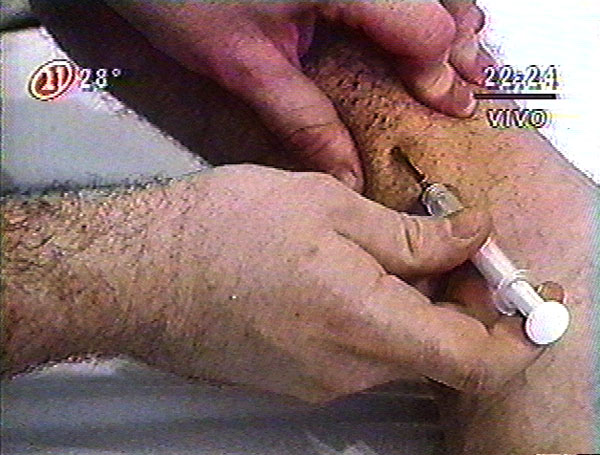
The moment of the implant as seen live on television and on the Web
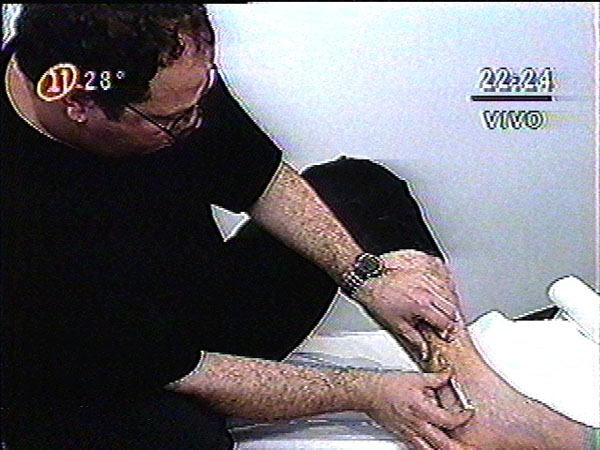
The moment of the implant as seen live on television and on the Web

The moment of the implant as seen live on television and on the Web

The X-ray of the implant
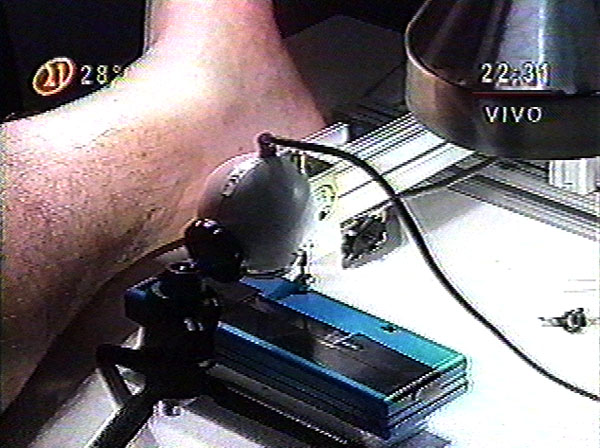
Webscanning of the implant as seen live on television and on the Web
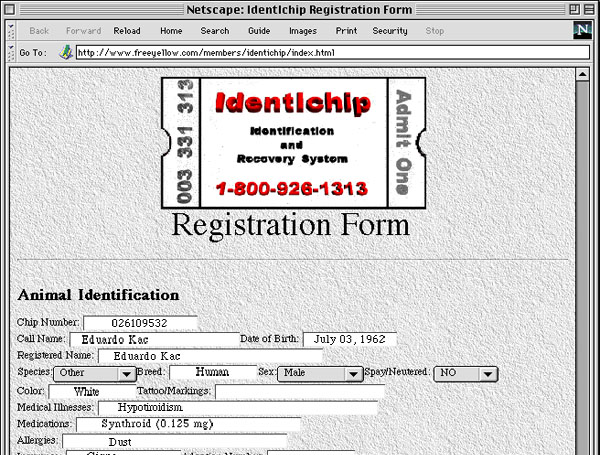
Top of the database page in which Eduardo Kac registered himself as both human and animal.

One of the seven sepia-toned photographs that make up "Time Capsule"
EXPANDED DESCRIPTION
Time Capsule is an installation that consists of seven sepia-toned photographs, an x-ray, and a flat screen mounted with a microchip and a syringe. The piece further develops a performance by the artist that took place in 1997 at the Casa da Rosas, in Sao Paulo, Brazil. During the performance Eduardo Kac implanted a microchip into his ankle live on TV and on the Web. The type of chip he implanted is used for registration and recovery of lost animals and contains a sequence of numbers: 026109532. After insertion into his ankle—an area of the body emblematic of slave and prisoner containment—the chip was scanned through the Web. An integral part of the performance, this remote scanning of the digital information inside the artist’s body was also transmitted live on Brazilian television. Still live, the artist registered himself via the Internet in a remote database as the animal to be identified as well as the owner of the animal.
The piece is itself a time capsule containing elements that allude to the past, present and future. The sepia-toned photographs of the artist’s ancestors in Poland before 1939 stand for the past. The x-ray reveals the present, the chip that is still today inside the artist’s body. The flat video screen shows the artist implanting the microchip, a technology that in 1997 was considered part of a distant human future but which is progressively becoming more socially widespread, as exemplified by its current official use in hospitals and among hacking communities. The artist has also speculated that microchip implants will become more common in contemporary art in the future.
Time Capsule is also about memory, migration, and mutation. The artist implanted the microchip in front of the seven sepia-toned photographs to establish a contrast between the analog externalized memory (photograph) and the digital internalized memory (microchip implant). While microchip implants can save lives (of lost animals, of unconscious hospitalized humans) it can also be used as a tracking and surveillance technology, raising serious questions about identity and privacy. Surveillance of public spaces may one day, Time Capsule warns us, be complemented by surveillance of private data in our bodies. The piece is also exemplary of Kac's continuously evolving reflection on the relationship between humans and animals, and suggests that digital technologies may give rise to new hybrids of animal, machine, and networks.
When a remote participant scans the artist (i.e., retrieves the information contained in the chip), the artist does not feel anything. The record of the presence of the artist is placed outside of himself seamlessly. This is similar to how movements of humans today can be traced by records of use of cell phones and ATM cards. The action of inserting a chip inside the body raises issues of who has access to and control of memory. Time Capsule poses questions about the human condition in the digital age and who has control of the body and the codes present within it.
EDUARDO KAC
RESUMÉ
Birth: Rio de Janeiro, 1962
Lives and works in Chicago
Recent Solo Exhibitions
2006 "Installations", Fundación Telefónica, Buenos Aires (forthcoming)
2006 "Natural History of the Enigma", Weisman Art Museum, Minneapolis (forthcoming)
2006 "Black Box Gallery", Copenhagen (forthcoming)
2005 “ Move 36 ”, Galerie Biche de Bere, Paris
2004 “ Rabbit Remix ”, Laura Marsiaj Arte Contemporânea, Rio de Janeiro
2003 “ Maybe Then, If Only As ”, Butler Institute Of American Art, Youngstown, Ohio
2002 “ Free Alba! ”, Julia Friedman Gallery, Chicago
2001 “ Genesis ”, Julia Friedman Gallery, Chicago
2001 “ The Eighth Day ”, Institute for Studies in the Arts, Arizona State University, Tempe
Selected Recent Group Shows
2006
Singapore Biennale (Forthcoming)
Museum of Contemporary Art, Chicago, "Artist and their Kids" (Forthcoming)
Kunstraum Dornbirn, Austria, "Destroyed Worlds and the Utopia of Reconstruction" (Forthcoming)
University of Essex Gallery, United Kingdom, "Visual Poetry” (Forthcoming)
Santander Cultural, Porto Alegre, Brazil "Chateaubriand Collection" (Forthcoming)
MAK Los Angeles, "GenHome" (Forthcoming)
2005
MAXXI - Museum of Art for the XXI Century, Rome, “ Tempo e Spazio Nell’Arte in Rete ”
Maison Européenne de la Photographie, Paris, “ Quando? ”
Centro Cultural Conde Duque, Madrid, “ Move 36 ”
Museu de Arte Moderna, Rio de Janeiro, “ Gilberto Chateaubriand’s Collection ”
Zendai Museum of Modern Art, Shanghai, “ Reversed Mirror ”
University Gallery, University of Essex, UK, “ Subverting Reality ”
Regina Gouger Miller Gallery, Carnegie Mellon University, "Animal Nature"
Center for Art and New Technologies, Las Palmas de Gran Canaria, Canary Island, Spain, "Move 36"
NIU Art Gallery, Chicago, "Re-form"
2004
Gwangju Biennale, Gwangju, Korea, “ Move 36 ”
XXVI Bienal de Sao Paulo, Brazil, “ Move 36 ”
Linda Schwartz Gallery, Cincinnati Ohio, "drift:shift ”
Frederick Weisman Museum of Art, Minneapolis, “ Genesis ”
Experimental Art Foundation, Adelaide, Australia, “ Art of the Biotech Era ”
Fundación Telefónica, Santiago de Chile, "Genesis"
Kunst und Kunstgewerbeverein, Pforzheim, Germany, "Face/off – Body Fantasies"
University of Notre Dame, Notre Dame, IN “ &NOW Festival ”
Art Chicago, with Linda Schwartz Gallery, “ Fossil Folds ”
Itaú Cultural, São Paulo, Brazil, “ Emoção Artficial II ”
Museo de Arte y Fundación Telefónica, Lima, "Genesis"
Mary and Leigh Block Museum of Art, Evanston, Illinois, "Genesis"
2003
16th Stuttgarter Filmwinter – Festival for Expanded Media, Germany, “ Defining Lines: <Breaking Down Borders> ”
Museu de Arte Moderna de São Paulo, São Paulo, "2080"
Scarfone/Hartley Gallery, University of Tampa, Tampa FL, "Electronics Alive"
Art Center Le Noroît, Arras, France, "Terminal Zone"
Ronald Feldman Fine Arts, New York, "American Dream: A Survey"
The Graduate Center Art Gallery, The City University Of New York, "DNAge"
Lieu Unique, Nantes, France, "L'Art Biotech"
Julia Friedman Gallery, Chicago, "Works on Paper"
Centre international de poésie de Marseille, Marseille, France, "Terminal Zone"
International Artist's Museum, Venice, "Wandering Library"
Contemporary Art Museum, Monterrey, Mexico, "Genesis"
La Casa Encendida, Madrid, Spain, “ Humillación trauma y producción del sujeto contemporáneo"
Berkeley Art Museum, Berkeley, California, "Genesis"
Videobrasil, Sesc Pompéia, São Paulo, "Time Capsule"
Paris Expo, Porte de Versailles, Paris, "Foire Internationale d'Art Contemporain" (FIAC)
Salle du quai Antoine 1er, Monaco, "Chimères, Monstres et Merveilles, de la Mythologie aux Biotechnologies"
Ivan Dougherty Gallery, Sydney, Australia, "Light from Shadow"
Itaú Cultural , São Paulo, Brazil, "A Subversão dos Meios"
Museo Nacional de Bellas Artes, Buenos Aires, Argentina, "Genesis"
Carrousel du Louvre, Paris, "Paris Photo 2003"
Govett-Brewster Art Gallery, New Plymouth, New Zealand, "Genesis ”
2002
Museo de Arte Moderno de México, Mexico, “ El Final del Eclipse ”
Cité des Sciences et de l’Industrie in Paris, “ L’Homme Transformé ”
Kunsthaus Merano Arte, Merano, Italy, "Eurovision - I Biennale d’Arte : DNArt; Transiti: Metamorfosi: Permanenze"
University Gallery, University of Essex, United Kingdom, “ Transit ”
Museu de Arte Moderna, Sala Città America, Rio de Janeiro, Brazil, “ Entre a Palavra e a Imagem ”
Centre D'Art Contemporain, Hérouville-St-Clair, Normandy, France, “ Poetry and New Media ”
Deutschen Hygiene-Museums, Dresden, Germany, “ Mensch und Tier. Eine paradoxe Beziehung ”
Georgia Tech University, Atlanta, TechnoPoetry Festival ”
Galeria Nara Roesler, São Paulo, Brazil, "Portão 2"
Manifesta 4, Frankfurter Kunstverein, "Defining Lines"
Maison Européenne de la Photographie, Paris, “ Festival d'art numérique@rt Outsiders ”
Museo de Arte Extremeño e Iberoamericano de Arte Contemporáneo (MEIAC), Badajoz, Spain, “ El Final del Eclipse ”
Universidad de Salamanca, Salamanca, Spain, “ El Final del Eclipse ”
2001
Yokohama Triennale, Yokohama, Japan
Woodstreet Galleries, Pittsburgh, “ Interactive Domains ”
Wilhelm Lehmbruck Museum, Duisburg, Germany, “ Beyond the Skin - Biological Metamorphosis in Contemporary Art ”
San Francisco Art Institute, “ Telematic Connections ”
Austin Museum of Art, “ Telematic Connections ”
Atlanta College of Art Gallery, Woodruff Art Center, “ Telematic Connections ”
Oklahoma City Art Museum, “ Telematic Connections ”
Robert V. Fullerton Art Museum/California State University, San Bernardino, "Out of Context"
Itau Cultural, Sao Paulo, Brazil, "Luz na Arte Brasileira"
NY Center for Media Arts, New York, "Electronic Maple"
Tang Museum, Syracuse, New York, “ Paradise Now ”
Kaohsiung Museum of Fine Arts, Kaohsiung, Taiwan, “ Kaohsiung International Container Arts Festival ”
Thomas Blackman and Associates, Chicago, “ The Stray Show ”
China National Museum of Fine Arts, Beijing, China, “ Holopoetry ”
Palacio de los Condes de Gabia, Granada, Spain, “ El Final del Eclipse ”
Public Collections
Museum of Modern Art, New York
Museu Nacional de Belas Arts, Rio de Janeiro
The Butler Institute Of American Art, Youngstown, Ohio
University of Essex, Essex, United Kingdom
The Frederick R. Weisman Art Museum, Minneapolis, MN
Museu de Arte Moderna, Rio de Janeiro
Museum of Holography, Chicago
MIT Museum, Cambridge, MA
Museu de Arte Contemporânea da Região Amazônica, Belém, Pará, Brazil
Harvard University, Houghton Library, Department of Printing & Graphic Arts
Joan Flasch Artists' Books Collection, Chicago
Private and corporate collections in Chicago, Paris, São Paulo, Miami, Houston, Berlin, Essen, Cincinnati, Kassel, London, Kansas City, and Los Angeles, among others.
Books
About Eduardo Kac's work
Eduardo Kac : Move 36, Elena Giulia Rossi, editor, Paris: Filigranes Éditions, 2005, 80 p.
The Eighth Day : The Transgenic Art of Eduardo Kac, Sheilah Britton et Dan Collins, editors, Tempe: The Institute for Studies in the Arts, Arizona State University, 2003, 117 p.
Eduardo Kac : Telepresence, Biotelematics, Transgenic Art, Peter Tomaz Dobrila and Aleksandra Kostic, editors, Maribor : Kibla, 2000, 144 p.
Eduardo Kac's own writings
Telepresence and Bio Art – Networking Humans, Rabbits and Robots, Ann Arbor: University of Michigan Press, 2005, 311 p.
Luz & Letra. Ensaios de arte, literatura e comunicação [Light & Letter. Essays in art, literature and communication], Rio de Janeiro: Editora Contra Capa, 2004, 429 p.
General Bibliography
Kac's work has been featured both in contemporary art publications (Flash Art, Artforum, ARTnews, Kunstforum, Tema Celeste, Artpress, NY Arts Magazine, Lapiz) and in the mass media (New York Times, ABC, BBC, PBS, Le Monde, Boston Globe, Washington Post, Chicago Tribune, El País). Kac's work has been featured in numerous books and catalogues.
Critics, curators and art historians who have written about Kac's work include: Didier Ottinger, Linda Weintraub, Frank Popper, Edward Lucie-Smith, Paulo Herkenhoff, Steve Baker, Jon Ippolito, Carol Becker, Gunalan Nadarajan, Katherine Hayles, Annick Bureaud, Edward Shanken, Gerfried Stocker, Pier Luigi Capucci, Jim Elkins, and Machiko Kusahara, among others.
Eduardo Kac is represented by:
Black Box Gallery
Sneppevej 3 IV t.h.
2400 Copenhagen – Denmark









